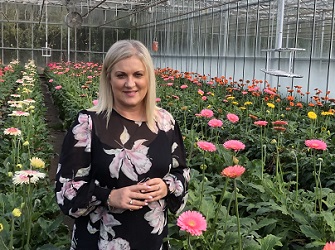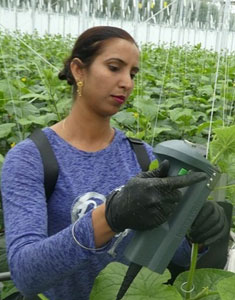Sign up here to subscribe to the Grower2grower Ezine. Every two weeks you will receive new articles, specific to the protected cropping industry, informing you of industry news and events straight to your inbox.
Nov 2023
Taking Fruit Production to the next level

Most fruits will respond to protected cultivation cropping and hydroponics – by Dr Mike Nichols.
When I was an undergraduate (nearly 70 years ago) I recall a lecture given by a certain Professor Hudson who demonstrated the importance of the environment and of knowledge on horticultural crop production. See Fig 1.
Essentially, he demonstrated that the most successful growers produced the biggest crops due to adequate capital and knowledge (i.e. ‘making less mistakes’ than the other growers). He was also able to demonstrate that the record yield (almost certainly produce by one of the top 10% of growers) could be defined as a good luck bonus, due to an exceptional set of weather conditions. There was also a genetic potential (of which more later). See Figure 1.

Fig 1. Hypothetical horticultural crop yields.
He then compared the crop yields of an outdoor crop (potato) with that of a greenhouse crop (tomato) in 1950, however there is an important change in the pattern. (see Fig 2). The difference is because the gain from knowledge for the outdoor crop is considerably less (proportionately) than the gain from having an exceptionally good growing season (which accounts for the record crop), while in the greenhouse the environment (weather) is controlled to a reasonable extent by the more knowledgeable growers, and therefore the record yield increase is much smaller.

Fig 2 Actual yield data (1950) of field crop (potatoes) and greenhouse crop (tomatoes). Note: the yields for the two crops have a different scale. If we look at the sort of yield pattern one might expect in 2010, the same pattern is apparent, (Fig 3) but the yield in the greenhouse tomato crop has increased significantly (see Fig 4).

Fig 3 Yields of potatoes and greenhouse tomatoes in 2010

Fig 4 Comparative G/H tomato yields 1950 and 2010.
This huge increase in productivity (4X) is due to a combination of factors, including, improved genetics, better (more modern greenhouses, improved environmental control, improved pest and disease management, and hydroponics, which has ensured minimal water and nutrient stress. Many (if not all) of these factors could be applied to fruit production.
Hydroponics is probably a key factor, as it is impossible to ensure that plants growing in the soil grow without moisture and nutrient stress.
The fruit industry has already seen this development with berry fruit, and it is only a question of time (when not if) before other fruit crops move in a similar direction. Early movers are likely to be the rain sensitive stone fruit (particularly cherries), using the dwarf+ root stocks (such as Gisella).
Slowly other fruits are moving under protected cultivation systems, e.g. dessert grapes and other rain sensitive fruits.
In fact, New Zealand soils (with a few exceptions) are recent soils which have developed from volcanic activity and can suffer from a deficiency of critical elements for plant growth and also for animal health. E.g. the pumice soils in the North Island.
Most fruits will respond to protected cultivation cropping and hydroponics, by producing more rapid growth and better-quality crops, so the question is not what can be grown in this manner, but the economics of the operation. Environmental constraints may also play a role, for example strawberries can be grown outdoors in the soil, but are very sensitive to rain, and in greenhouses (as simple rain shelters) are of much better quality, and when combined with a table=top cropping system, much easier (and cheaper) to harvest. Rain sensitive fruits (such as cherries) will also be of higher quality as rain on the ripening cherry fruit produces unmarketable fruit due to splitting. Having a structure (rain shelter) over the crop also enables bird netting to be supported. An important consideration for cherries and grapes. Apart from berry fruit this trend has not occurred in fruit production.

Global warming predictions are for the increasing occurrence of extreme weather conditions, e.g. extreme rainfall or extreme droughts. Over the past 50 years we have seen the steady transfer of vegetable crop production from the field into greenhouses as the consumer (i.e. supermarkets) demand more regular supplies of higher quality produce. This trend is likely to accelerate with global warming.

Labour availability is an increasing problem in fruit production, and working in a greenhouse when it is cold, wet and windy outside is preferable for most people. Worker efficiency is also likely to increase in a sheltered environment.
Where to from here!
This is clearly only a single step on an ever-changing system of horticultural crop production. These changes, extreme though they may appear, are but a step away from the development of plant factories (also called vertical farming) in which crop production occurs year-round in the towns and cities where the food is to be consumed and thus distance from market is no longer a factor. The plant factory will be far more productive than in the field or the greenhouse, will be lit by LED lights, with electricity. Crop production will be year-round, with some crops receiving light for 24 hours/day to obtain greater productivity. Accurate control of the essential environmental factors which control plant growth such as temperature, humidity, air movement, CO2 level etc will ensure that plants are able to achieve their genetic potential. This type of production has already begun in New Zealand with year-round strawberry production in Foxton by “26 Seasons”.
As this production method develops world-wide, the potential for exporting fruit from southern hemisphere countries, such as New Zealand, Australia, Chile, South Africa to the northern hemisphere, will disappear, as would the freighting to New Zealand of expensive out-of-season fruits from overseas.

The key to this development will be cheap electricity (probably from nuclear fusion), and the development of a new indoor production growing technology. For example, it may be possible to produce several crops per year from apples ‘trees’, in which winter dormancy is a few weeks, and the growing period is all at the optimum light and temperature for growth and development. Locally produced ‘tree ripened’ fruit would-be available any day of the year!!! In the 1970’s the Long Ashton Research Institute in England proposed the concept of a “meadow orchard”, of high-density knee-high fruit trees. This could become a reality in the future with the development of plant factories.
We have a long way to go and a lot to learn.

Images
- Dessert grapes in high tunnels
- Strawberries in high tunnels
- Cherries in high tunnels (Wee Red Barn, Masterton).
- Apricots in high tunnels
CLASSIFIED
Photo
Gallery
Subscribe to our E-Zine
More
From This Category

Horticentre Charitable Trust Continues as Exclusive Sponsor of Grower2Grower 2025

Horticentre Charitable Trust Continues as Exclusive Sponsor of Grower2Grower
Governance and Board Training

Aussie growers band together to boost the whole berry basket

New training programmes for indoor crop production
























































